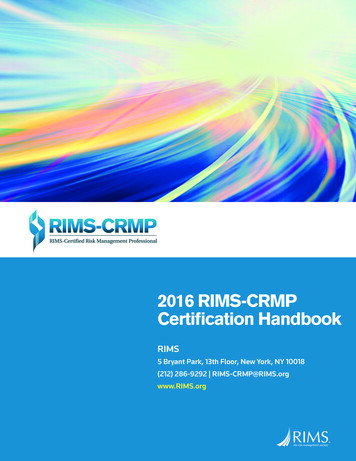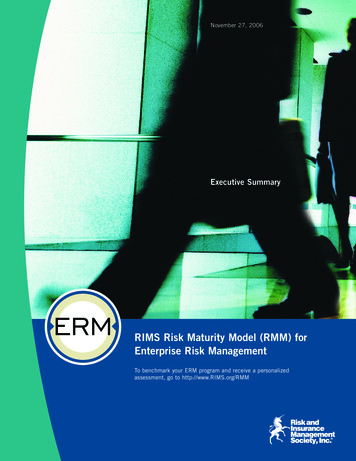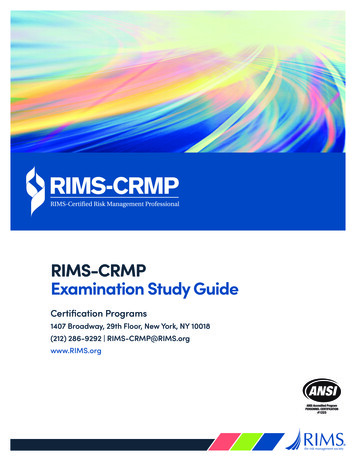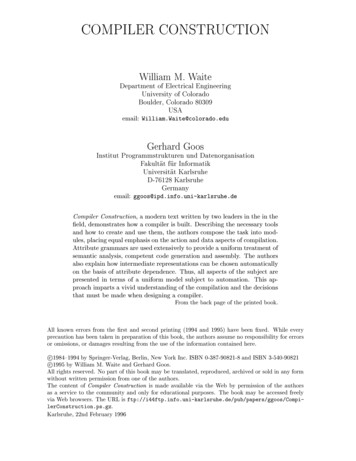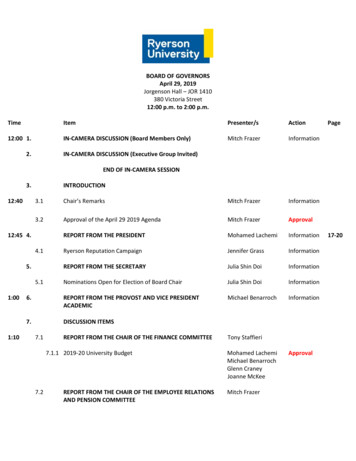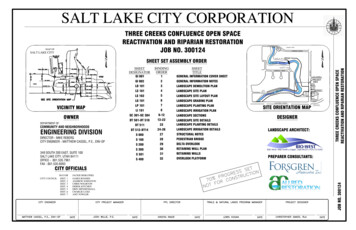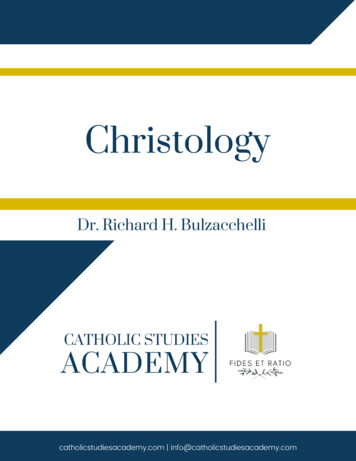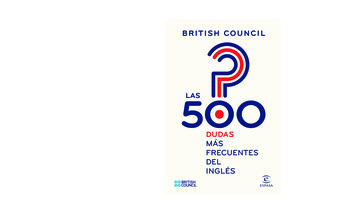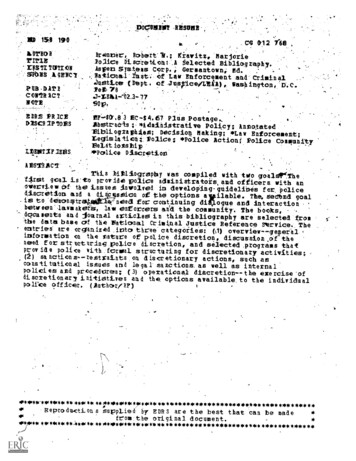
Transcription
G12 168sgargrtisTZTEraiINBrenner, RobTi,; remits, a jorPolice Discrn;telected Bibliography.Aswan Systeas Corp. , Germantown, rd.laticnal last. Of Law Enforcement and CriminalPUB .DITElet 78NOTESOp.OrliORrimsRS WkICE;Justice ( Dept of JispIceiLtil)Wash ingtonD. C.EF--SEr,8 3 EC-S4.67 Plus Postage.Abgtrad*kdainigtrative Policy;DUCH 7P101?8otated13ibliographles; Decision Raking; *Law Enforcement;folice ; *Police Action; olive Colman1.2EVITIF IEBS,*Police DiscretionA13STACIVeLat ions bi p,tThis flit hographywas compiled with to goaldr,Thef4rst goal isto provide police adeinistratoks,and officers with anoverview cof the issues involved in developing- guidelinespolicediscretion and a dis;FIsaien of the options avilable. The,for,sleet:magoalis to devonwtruqgalecneeafor continuing diatiogue and interactiondocusents and journal articles in this bibliography are selected frogthe data base af the Itetional Criminal Justice Reference Mrvice. Theentries' are or4anized rintos three categoties: (,1) overvievgs,nerUlinformation on the nature of police discretion, discussion .of theneed f or sir ucturing police discretion, and selected programsthatprov ids police with formial structuring for discretionary activities;(2) sa nationsrestraints on discretionary actions, such asonsti tuitional issues and le ga 1 sanctions. as well as internalpolicies and procedures; (3) operational discretionthe exercise ofdiscretionary initiatives and the options available, to the individualpolice officer. (AuthrtliP)between' lawmaker's, lam enforcers and the community. The books,4c**Reprodu-ction26(4g****** :***gt*sit****4,******** ******** ** * ***plied. by EDRS are the best t t can be madefrom:the original document.*ft*** tit********************* ****** ***
tiV S 6 EPAIRTME NT OF NE LIP EDUCATION A WELFARNNATIONAL INSTITUTE OFEDUCATION -THIS DOCUMENT HAS BEEN REPRORECEIVED PROMDUCE EXACTLYTHE PERSON ON ORGANIZATION ORIGIN ATING IT POINTS OF VIEW OR OPINIONSSTATED DO NOT NECESSARILY REPRESENT OFF 10 AL NATIONAL INSTI TUTE OFEDUCATION POSITION OR POLICYNational Institute of Law Enforcement and Criminal JusticeLaw Enforcerrient Assistance AdministrationUnited States Department of Justice
National 'mina! Justice Reference ServiceBox 6000Rockville, MD 20850
POLICE DISCRETIONA Selected BibliographybyRobert N. BrennerMarjorie KravitzNational Criminal Justice Reference ServiceFebruary 1978NINational Institute cif Law Enforcement and Criminal Ju tic. Law Enforcement Assistance AdministrationUnited States Department of Justice
ionatInstituteLaw Err orcement and Criminal JusticeBlair G. EirringActing'DirectprLaw Enforcement Assistance AdministrationJarnet M. ki. Gregg.Acting Adrninistrotor(.Prepared for the National Institute of Law Enforcement and Criminal Justice. LaNe Enforcement Assistanpe Administration, U. S. Department ofJustice by Aspen Systems Corp . under contract number J-LEAA-023-77Points of %neemr or opinionstated in this dOcument are those of the authorsand do not necessarily represent the official position or policies of theU, S Department of Justice
TABLE.ntroduction:.O000000.vvii.ow To Obtain These DocumentsOverview0# . .60' . 000#11'.1SanctionsA.6nstitu onal issues and legal sanctions.B.Policies and procedures.Operational Discretion .60 000d39V*5500#.Appendix A - Published Standards'Appendix B - List of SourcesAppendix C - Resource List.- 29000-. .798187
114TRODUCTION,The concept of police didcretion and, the issues surrounding thislaw enforcement decisionmaking process have been eht subject ofcontinuing debate and concern. The controversy hasAnvolvedlegiSlative bodies and the community as well as the components ofthe.criminal justice 34stem. At the most basic level of law enforbement, each police officer must exercise disrretion.in hisdayi-toffy -raetivities 7-e- and in doing go oust reconcile his oathof office and the statutory requirements of full enforcement with.the realization that full enforcement is not'attaimehle.the reasons why full erkforcement.is not attAinableis -the-availability of limited resources for law enforcement.Other contributing factors include the enactment of laws by legislative bodies not fully cognizant of their enforceability by police, the judicial interpretation of the formality, of the lawrather than the reality of the law, and the community's perception of ordto maintenance and law enforcement,Foremost. anonWithout thp benefit of guidelines to, structure discretion, thepolice officer actually formulates policy as he reacts to individual incidents based on his perception of the realities, his exThisperience with the ralitie4, and his individual moral code.individualized interpretation has historically placed law enforcement in the defensive position of having to react to complaints ofdiscriminatory law enforcement-that have resulted in an undermining of public attitudes toward the police as well a i6luencing judicial rulings regarding police actions.In 1973, recognizing the need for policy guidelines, the NationalAdvisory Commission on -Criminal Justice Goals and Standards recommended that every police agency establish guidelines for.policeThat same year the American Bar Association and thediscretion.International Association of Chiefs of Police approved Standards--I.-Relating to the Urban Police Function that also recommended theThe publisheddevelopment of guidelines for police discretion.standards of both groups identify potential benefits that wouldderive from established policies, such as. the resultant uniforlhenforcement policy, improved productivity; and a better understandingby courts, legislative bodies, .and the community of the nature ofpolice operations. These published standards are presented in theAppendix to this biblio.graPhY.
This bibliography was compiled with two goals:First, to pro dthe police administrator and the police officer with an overviewof the issues involved in the development of guidelines for policediscretion and a discussion of the options available; and second,to demonstrate the. deed /dr continuing dialog and interaction between those groups most concerned with the subject,-- lawmakers,law enforcers, and the community.The. books, documents, and journal articles in this bibliographywere-seleeted-froM the data base of the nationai'CtiAlftel JusticeReference Service with a view toward presenting a-cross sbction:of the available literature. The entries are organized int-o.threemain categories:Overview.-- General information on the nature of policediscret4on, discussion of the need:for structuring policediscretion, and selected programs that provide police wiehformal structuring fnr discretionary geEnTrErd.Sanctions -- Restraints on aiscretionary,actions, both external and- internalA.B.ConstitutiOnal issues and legal sanctionsPolicies and procedures.Operational Discretion -- The exercise of discretionary initiatives and the options available to the individual police officer.Within each section the entrname.Information about howfound on the following page.are alphabetized by author's surobtain the documents cited may bevi
HOW TO OBTAIN THESE DOCUMENTS.All of the documents in this bibliography are included in the'colleCtion of the National Criminal Justice Reference Service. TheNCJRS Reading Room (Suite 400, 1015 20th Street, N4W., Washington,D.C.) 1.s open to'the public from 9:00 a.m. to 5:00 p.m. ,All of thedoCuments cited are also available in, at least one of the followingthree Ways:/l.C/-'Permanent, Personal Co iesJrom Publishers' and:Other SourceThapublieher or availability source of each document is indicated in the bibliographic citation, and the names anddresses of the sources are listed by entry number in the.ArNCJRS cannot guarantee that all doCuments will (rependix.main available, but researchers preferring to acquire theirOM personal copies of the cited documents should contactthe source indicated.Free Microfiche from NCJRSWhen the word MICROFICHE' appears in the citation, a freecrofiche is available frown NCJRS. Microfiche is a 4 x 6inch sheet of film that contains the reduced images of upto 98 pages of text. 'Since the image is reduced 24 times, amicrofiche-reader is essential to read, microfiche documents.Microfiche readers are available at most public and academicRequests for free microfiche should include thelibraries.identifying NCJ numbers and be addressed toNCJRS Microfiche Programbox 6000Rockville, Maryland 20850Ill1122KIEtianfromH NC-TRSAll documents cited may be borrowed from NCJRS through yourDocument loanspublic, acadenilc, or organization library.are not made directly to individuals. A maximum of 5 documents may be borrowed at one time for a period of 30 days.Each document must be requested on a separate InterlibraryLoan Form addressed toNCJRS Document Loan ProgramBox 6000Rockville, Maryland 20850vii
OVERVIEW
Criminal JuStice -- Readings. Pacific Palisadesair Publishing Company, 1972.378 p:P.,California,(NCJ 01772),.This book presen tsspettsof the entire enforcement system with em.aphasic; on police. The readings are grouped in seven subject area'sections -- police role, police-selection and retention; profession-Jalisation, academic progress in law enforcement, police discretitin,-'critical issues4n criminal justice, and community relations. TherItluirement,for improvement of personnel capabilities and.the means,to that'end are central in most of the, papers. Many of the papetsprovide charted data and .references.T.Discretionary Justice And the Black'Offen er.In Owen, 9.Ed.,Blacks and Criminal Justice.Lexington, Massusetts, D.C. Neathand Company, 1977.(NCJ 43094)Misreport discusses the:mechanics through, which discretiohary powersare examined. Light is shed on the partial treatment-of the minorityoffender.The minority offender has been at se distinct disadvantageunder the' existsece of discretionary decisionmakinilsws.The attitudes, value system, characteristics of the person with the authorityto exercise discretion,' and the lack of guidelineS or -rules for reviewing decisions have contributed to this disparity. Discretionary powersin the administration of justice have been found to be particularly oppressive to blacks. Pour areas in which discretionary power is oftenabused are highlighted:police{ prosecution, the American jury sytiten, and judicial sentencing.Policeproeeduree in black communitieshave been found to differ from those in white communities.Objectivesin law enforcement in most communities are often those of the dominantwhite culture, and there is a need to increase police sensitivity tothe interests and needs of minorities. Ideally, the individual patrolman should be governed -strictly by administrative rules, wIth the discretionary power reserved for top level police personnel.The prosecutor's decision on whether or not to prosecute individuals is basedon his own judgment and is thus often influenced by subjective criteria:the offendsr's economic background, speechmanner; thenature of the crime; and public sentiment', among others. The GerMancriminal justice system, where)the prosecutor possesses no discretionary powers, serves as a guide for assuring equal treatment.Since alarge number of jurisdictions-choose prospective jurors: ftom voter registration polls, where blacks, other minorities, and the poor arenot registered in as peat a number as whites or middle- and upperincome groups, minority and poor offhnders are ofteh grossly under'represented on juries in the United States. These juries often harbor hostile feelings' toward the minority offender, whose backgroundthey do not understand. 4 suggested solution lies in restructuringthe jury. system so that minority communities and black populationsin the South are proportionately represented. Since there afeno setgUidelines to arrive at standards for sentencing, it depends largely
,.an the ledge's o rn .belief-biases; 0401 coded are cited which r:provide for prasentending.investigations and which limit judicial,.AiscretiOnle-on. The-fer controlled discretion: lies in admin7istrative Oilea set by the police, departmeuts,- ptesecutoreofficesoand courts i since, legislative intervention seems unlikely: Tieseretorts remain, nonethelesa, "band -aid" Soletions.A bibliographyis included.-7 Pre-PellimmtlIt2LtmljnialesL::Santa clam CountRe ote for Jul1972Octobei'l '197October-972 7 December 34 19W21 and Januarill- 19737?,Sen-jeee,-Celifornia, San i Clara t-COanty Juvetille-Prebitien-Vetrt7'-'183 p.cent, 197'3.(NW 14261),,MICROFICHEsThese reports concern a projecedesigned -to assist-12,county,lawen7forcement jurisdictions to expand and improve services to jftenilesin place of referral to the Juvenile Probation Department. The reports include overviews -of the 12 lee enforcement programs submittedby the project consultants.- Project elements included training ofpoiice officers in a knowledge of community agencies that serve luvenilea, referral procedures, and short-term counselinof youth andtheir families. The project report further includes a research pi07cedure for monitoring the implementation and effects of the program.Statistics considered relevant to measuring the effects, of the di'version - project are included in the appendixes.BOTTOMLEY, A. K.Decisions in the Panel Process.Jersey, Fred B. Rothman, 1973.269.p.South Hackensack, New(NCj 13196)This book examines the use of discretion in various stages of thecriminal justice systems in England and the United States. -The penalproqess in any country can best be understood not only by looking atits &ormal structure and legal basis, but by -closely examining thevarious pressureseand conAtraints which influence the- actual .operation ofvthe process.In an attempt to provide a framework for un7derstanding the penal process, this book focuses attention ondecisions which are taken at different stages of the process. Considerable attention is given to the relationohip-between criminalstatistics and social attitudes, with comments on tihe impact thatdiscretion in reporting and recording crimes has on the meaning and -7validity of statistics. Police decisionmaktng in law enforcement isdiscussed, focusing on the need 'for police. discretion in making arrests and the extent and variations in the type of dispositions madeby police at this stage of the penal process4 Highlights are givenof the decisionmaking process in the court and correctional systems,beginning with the granting of bail, through sentencing an offenderto prison or probation, to determining the date of Kman's releasefrom prison en parole.The fundamental themes ofis work, whichincorporate data from the American and English criminal justice4
s'itaesfr'include the nature and extent. of the exercise of discretionin criminal justice, the ambiguity of penal ob jec tives and the avail-aril ty of information which).inf luences decisioranaking.Soc letyAqLI:ILF'oliA11an s Role.arid icegan Paul Ltd. , 1973. 324, D.CAIN M- E.London, England, Rodtledge(N CJ 110439)ts- a sociological study of police origanizettion and behaviorirvErs gland, explaining police behavior Ira terrns of role. preseates anddefine itions. The study is based on research of a-leant literature,ioansire ,interviews with policemem and their wives, and .partieiPAnt observation of both urban and rural forces.The csrganiZat ionarid functions of sample forces are cut lined, and a description of thebeat policeman's job in rural and city police worlo i. is presented. Cistriter dependent relationships with the cortinuriity, his wife and fami ly,genial' off icers and col leagues are analyzed. Two ehief 'genera iliatf-ons may be made. Strong ties of 'mutual dependence (both verticallyarm horizontally) and evidence of insular attitudes showed the citypoblic de to be largely autonomous in their role definition. The con-vmrse was found to be true of the riira .1 police, who were much tune de-Pendent upon the community, socially as well as professionally. TheThisbookocon.xl generalization deals with the nature of the police role. Theur brtrw role, mainly de tined fro within the f orce, was one of "thieftaking," that is, criminal apprehension. The rural rule-, definedch lef Jy by the public , was one of "peace-lteePirig." rThe irfr li catiorasof these f indirigs in future po lice organt zat ion and management ereby the author. wilisNeg a trend toward a more autonomous,.mo reent&al tyro-1 p4)Eight pages of ref erences arein tiuded.Sone.lif.161rieniis31-:vrc11.-1,-,11t2f f ,,ndtrs7e Diver iuE a6lew.00dk.114187Nettiveiteeyer:(NC-.1 31751)ii, 4,,.,I1, L I,- i.:t., 1,. A.it 01du'ji issues ata diversionlabel lug of jove,liles, police discretion,di Ner9s1onary programs aild evalia tioa of the of fee ts of diversion.Thy s -lect ions presented in this text range from government reportsto uu, - ,Iologi cal studies. A background on juvenile di version is pro 'vi sled la the first sectioa, which incluides selections from the Reportde lii tions and wen hoofth.- --, ,President's Commission on law Ertforeerflent and the Admillistra-ticmi oaf Justice and the Task Force Report on Juvenile Delinquency.cing the issues cousi tiered in the second section are the organizaticiaat building ,Ap of sti goLvitizing labels and percept ioris of stigmafallow, log public lute& verition for de Unguent behav or. The need fo tguldeA Ines in police discretion acrd the effect of -ventle detentionare al a considered. Such diversionary programs as t rsditional lawenforcement diveraloo a plice-operated diversion program, and theYoothService Bureau a ke des crt be 4.Re search and eve lua tion of ja-verwile diversion are discussed in the f inal five selections.
Ed. Criminal .lustadmit. rth Publ ishinE C4ornPBelmontCalifornia,CJ 25794)This collection of articl es emphasizes the relationship between 10w.and politics within the context of the administriitive facet of thecrininal justice waters. Of particular importance is th, assumptionthat criminal jVstice is achieved through bargains or exchange relationships arrived at amohy- arti cipant s in the process and ifs inn.enced by politics, adminiStrat ve needs, and the community environment.To speak of the judicial prone s as a system with clearly defined goalsmay be misleading; rather, tiller e- a re many subunits , each with its owrtigoais and often having little I ikenes s to the need of society f or security- and justice. Each of the part s i s devoted to an examination ofo specific subunit of the criminal justice system. It is thus possibleto consider the treatment of de fendents, the organizational context o fdecisionnaking, and the influence of politics at each step from the'valise through judicial deferral rat ion of guilt or innocence. Thecif Lc subunits under examination are pol ice, prosecution, defenseattorneys , and courts.,pPont. ics a r),1this 15 a ,;r IL iyoc ort ion that the judlci ala lidJustice.1.11c Ad.141forni , -Sag e Pub 1 c at i ons ,234 p.n&AI of coalpr,,,ces sjll 511, iceyBeverly Hills, ca 3.(NCJ 11414)ern based on the assi.imp-Is a subsystem of the larger politicaleconomic sysi o alid that eux-181 dere-lac:Ms. are a factor in decisionThe vi ew that thcLatina], just Ice system is an of fi dentmaki ng.nRchca 1, .ortsitent process of dispensing justice to individualse protecting and prese Ivi rig social order and normative va lues isat:iig to the author.Police, prosecutors, defensecounsel, and judges, to ger her with community attitudes and the econ cc,: aridla 1 power of defy .!dentare considered to interact in acomp leI iice ri,1 Ay that -varies with each person's encounter,oilna 1crirn Aria 1ILidg&ajusti. c.y.h tern.po lice, prosecutors, defense counsel, andare e xanalledd iti dont o, [ha,The principal personnel of theInsti c.aysts.?,alay flea v*-1c he per 6p-eave of the socioeconomic conThe adranisat 1 Liak:tu d t hem CC, their roles.t rat lye , ,,01 It, tar. and soda 1 rata eus that affect the decisionmakingof ttiese peroof-trie 1e ,caralne d.Interpersonal interchanges t hattake pl ate behl r,d the scenes of the formal criminal justice system,such as plea bargaining, are aria lyzed and the pros and cons discussed.It i rronrnended thata Incite consistent treatment of defendandants wouldbe enhanced try int Ireasing the adversary context of the criminal justtine price ssappeal to LeaEmptiaiso,,a.,d rgested as waysactual dy,,,ani r. at w.,rkpE uvi (Ls a II lop. 1tconsi de c.rpr,ife sal ona- 1 norms, strengthening thetel iuicentive to defense counsel are s ugd th is. This book pur ports to bring a/.1Lt tie criminal justice process and thusLis tok mai Jun f ram whist, to discuss reform]
CIRSSFY, n.R. , Ed.Crime and Criminal Justice.Chicago, Quadrangle Books,(NC.3 31963)298 p.1 971this bocklection of 21 articles dealing with such sub jectsisa 8 t110 Inatijre,arid extent of the crime problem, the effects of recentlaws on cr im nal justice, criminal justice operations', and criminalris. Among the sPec fir topics covered in this anthologytust tee refate the of f cYq of business. and government corruption, a historical,limitations, and the effects ofgrowth of police legalAlso discussed are the/the rights of the offender.the operations of the Supreme Ccaurt, thenatute.' c col lc and use .6f experimental techniques such as woie,prfspy flmole playing, and drug rehabilitation programs. A finalOughtsectllort is devoted to proposals for improving various elements ofthe criminal jus tice system without damaging the social order or thereview Ofpr yt.lawsti ng.c ivi' riAvasII. liherti esK.ofci tiz ens.,A Preliminary Inquiry t Baton Rouge,245 p.Lovislarsa state University Press, 1969,(NCJ 10748)ndsc rot lonar-y JusticeC.Louisliatrte aromas of discretionary justice that are bef both judicial review and trial-type hearings. Thete1:11 I aSteadyyondthe reacauthor c,ntencls that our system of statutes and judge -made law isoverdeveloped and that our system of administrative justice, policelust icetice 1g underdeveloped.and pro Sec utConcrete propos-a is for re forrriirng our ay stem of discretionary justice are advanced,and the group dwo rk to x f urther empirical and philosophical studiesIt is recornme nded that unnecessary discretionary power bea ret hat better ways to confine, structure, and check nece li,nfnace,ibe found. The author develops a theory ofappl s it to concrete subjects, suck asessary C115 -re tick Liar y pow ertnaelLY actionrmerger ,learauces, selective enforcement andfrom public -housing, sentencing bydp 4)114--;Ylair 444 Liyul"p'1,1'taigas,pallyitor octItr, s u fe, v1 cl foi4srnU. ti.Pa r,Jle Board, and antitrust guidelines.ran. I, td1nhe6otd1.411,8 p.1975-L.WestaYaliag honeNCJ,,f11 4:4,425454)r 1Jday CtiruKLerneilL practices, thestothcPt rouod -ha 4 p u1 ice f. Isely pretend to enforce all criminal lawbecause that 16 edia t they believe the law requires them to do. Ap-p roxi InsLely i(10 Chi cago pwl ice atall levels were interviewed forthis stiady Fa,,11 o t the top HO( officers (the superintendent anddepur-Y supe,i rue ode tas) separately confirmed all facts. The auihoiconteqs thaterat-Keoris,folly enforce all criminal law for sevthe frequent legislative intent with respectpolice ci:alLinot-tptca:spect fie c t lthfna 1 s3tg rutenoughFurdr 4. -)411111,1 ifand the usual appropriation of onlyto two thirds of full enforcement.He
argues that false pretense prevents -open selective enforcement policy,prevents special studies of enforcement policy, prevents enlistmentof public - participation in policymaking, and discourages the policefrom coordinating their enforcement policy with the policy of prosecutors and judges. The author maintains that open selective enforcement is legal and should be made part of express police enforcementpolicy.His thesis is as follows: (1) that the false pretense shouldbe terminated, (2) that the selective,enforcement policies should beopen, 43) that top officers should make the overall policies, (4) thatthey should use professional staffs for making it, (5) that for muchof it they should use rulemaking procedure of the kind that Federaladministrative agencies customarily use, and (6) that patrolmen shouldno longer make overall enforcement policy. Fourteen Separate reasonsfor open selective enforcement are summatized. 'Also considered is thecase law on Judicially required administrative rulemaking, along withvarious judicial techniques for imposing that requirement.A discussion of the right mix between police rulesand police discretion rebuts the idea that rules necessarily replace discretion, emphasizesthe utility of rules to reinforce and to guide discretion, and proposes that patrolmen should have discretion to individualize the application of enforcement policy that is centrally made. The appendixcontains an account of the interviewing process used in this study.12.IJ iiuiinail arit.i of nLeach of the Peace Statutes -- A NonpenalFORCE, R.Approach to Order Maintenance.Tulane Law Review, v. 46, n. 3:367-445.February, 1972.(NC./ 05275)1hiti rtp,.ntaia. g.,t i.,i ,0 tui a formal conceptual separation ofthe law as it relate to law entyrcenent and as it relates to keepingthe peace.Breach of peace is a generic term that includes a varietyof offenses.There aie two key elements in an action for breach ofpeaceit most involve behavior that is public, and it must referto behavior that could lead to physical conflict. There is muchovurlap and duplication of -state and local ordinances regardingThe aoth,,r states ihat,iu many cases police aiiJp, act.fiatctveoti.0 arc unwarranted. Where initial intervention isAll that is regutc,d or the best that can be done, he states that it,matter should end there,Where, however, community resources may bebrought to bear on underlying problems, those resources should bemade available outside the context of the criminal law.Criminallaw should be used only in cases of severe harm or repetitive behaviorfor which ihe,e is no ()the. immediately available solution.In addition to pteposiog . civil order maintenance statute, the author alsopresents d summary of English and U.S laws dealing with breach ofbreachpeace.
13 Community Relations and the Administration of Justice.443 p.John Wiley and Sons, 1975.(NCJ 16492)CFARYl-1.'-This hook presents basic concept a from the fields of history, psychology, communications skills, law, and sociology which stress understanding of human beings and how to operationalize this understandingIn a practical way for police. A historical explanation of the policerole,, a discussion of teffects of societal charages on police work,rrand an examination of te Offerent rule concepts for police workingwith citizens are first prom- ed.Changes that are taking place inpolicing are discussed, and sug estions on how to help police copewith these changes are offered.sychological factors affectingpoliice-community relations, differways in which people communicatewith ear other, and some factors such as bias orescapegoating whichinterfere with communication are discussed. Police7-press relationsand the difference between public relations and police-community relations are explored as well.Other topics discussed include destructive police practices, selective and discriminatory enforcement of-law,s, community control of police, militant organizations and dissident groups, conflict management, and the impact of police-communityrolattons on the police !Tivstem,14.OOLDSMIM,and S,1.an Oc, .LiPatiooal SuGculturePublishers, 1974.299 p.Dimensions ofPolice Communityrat-1U, Palisades, California, Palisades(NCJ 14809),11,,Ii,,,.riled aich the occupational, psych.)I,grcd1pAir.,,r1. and 5, IAA dimensions of the police community.he nolice commonityattnots t, identify and define those distinctive,ultutal auJ hehavioral patretns that are associated with the occupational r,le ,Jf the pn11 eman.Authoritarian acting out, intradepartILLeutal .DolAqi.c,aLl,n, ,,,ii the trataJng of recruits by senior patrolmen'the taLE [:, ,tiaL ac,ordiog to the author S, tend to perThe concept of the pollee i umniunitypet-3i,, tLi, ,oh olt,irll patteirc.tire thee ,)tlici-ihoe,.-,,,,,p-ratedintof organizingLolly Jime,ions for the purpos,,,n,:lti,,.al dimension considers the policeman asiIlliailhis tole a worker.The Teadiugs in this section,Attempt t, d-Lerhow m,mb,tslcip in tt,e police community shapes onthe -foil hedvi,J/ ylt,i l,, ,w his uniquetlt, situation affects the policepert.Tie pnYChuiAl timeosion refersthe existence and naturethe rc-,o itolesITi ,,,,11,e 1.--r!,0on l i t y L VileSwhe of these readings equate the police persou,tity with a-thorirarianism, while others portray it as a:ly to berefl,ction ,t th,-, sucial gcrops from which police arere,rottedrie p liti,,11 dimen,,,ion is concerned with tl!'r political11,1cre,L Mru.ip activiLleS, the policeman as an agent orphem,wie,idgovernment, Lhe poliu. political ideology, and local community powerFinally, the social dimension readings exover pulik e activities.Amin, the LLE-ore ,,t- r:L IL so(i.lizLion from the perspectives ofpolice 5411 dati.,id [teelevelopment of codes of behavior.1
15.esitionelp'f aHALL, D. J. Role of the Victim in the Prosecution and II)Vanderbilt Law Review, v. 28, n. 5: 931 -985.Criminal Case.(NCJ 34071)October 1975.and evaluates the ways in which a victim caninfluence the course of acriminal case, from investigation and arrest to parole release and clemency. This study focuses on a frequently observed situation: -the police officer or the pirosecutor,each of whom is given broad discretion in the exercise of his responsibilities, has some evidences of possible criminal involvement butis unsure of how to proceed with the case, if at all. Given thiscan the adamant victim of the crime persuade the policemanor prosecutor to pursue the arrest or prosecution? If the victim'swishes are taken into account, do any patterns of dectsionmaking surface actording to the crime involved or the stage at which the influence i
When the word MICROFICHE' appears in the citation, a free crofiche is available frown NCJRS. Microfiche is a 4 x 6 inch sheet of film that contains the reduced images of up to 98 pages of text. 'Since the image is reduced 24 times, a microfiche-reader is essential to read, microfiche documents. Microfiche readers are available at most public .
